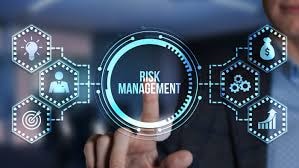Guarding the Digital Frontier: The Critical Importance of Cyber Security Risk Management

Introduction
In today’s interconnected digital world, cybersecurity has become a crucial aspect of every business, regardless of size or industry. With the rapid advancement of technology and the increasing reliance on digital platforms, the risk of cyber threats has grown exponentially.
Cybersecurity is not just about protecting data; it’s about safeguarding the very foundation of modern business operations. From financial transactions to customer communications, all normal business processes of the digital landscape is fraught with potential vulnerabilities that can be exploited by malicious actors.
This article aims to shed light on the critical importance of cybersecurity risk management. By understanding and mitigating the potential risks associated with cyber threats, businesses can ensure the integrity, confidentiality, and availability of their data.
We will delve into the various types of common cyber threats, their potential impact on businesses, and the essential strategies for effective cybersecurity risk management. Additionally, we will explore how professional services, such as those offered by Beyond Technology, can provide comprehensive advice to protect your business in this ever-evolving digital landscape. It is essential to implement tailored cyber security controls and governance to address the diverse and evolving threat landscape effectively.
Understanding Cybersecurity Risk Management

Definition and Key Components
Cybersecurity risk management involves identifying, evaluating, and mitigating the risks related to cyber threats to safeguard an organization’s digital infrastructure and data assets. It involves a systematic approach to managing sensitive information to ensure its confidentiality, integrity, and availability.
Key components of cybersecurity risk management include risk assessment, threat identification, vulnerability management, and incident response planning. By implementing these components, businesses can proactively address potential cyber security threats and reduce the likelihood of a cyber security incident.
Importance of Proactive Measures
Proactive cybersecurity measures are essential in today’s threat landscape. Rather than waiting for a breach to occur, proactive strategies involve anticipating potential threats and implementing both defenses to prevent them, and response plans to address them. This approach minimizes the risk of data breaches, and potential financial losses, and reputational damage.
Proactive measures include regular security audits, employee training, response planning, attack simulations as well as deploying advanced security technologies such as a security service edge, intrusion detection systems, and advanced authentication systems. By staying ahead of potential threats, businesses can ensure robust protection for their digital infrastructure and maintain the trust of their customers and stakeholders. Cyber security professionals play a critical role in implementing these proactive measures, ensuring systems and end-users are protected from various cyber threats.
The Rising Tide of Cyber Threats
Overview of Increasing Cyber Threats
The digital age has brought about an unprecedented increase in cyber threats. Cybercriminals are becoming more sophisticated, using advanced techniques to exploit vulnerabilities in systems and networks. Businesses face a myriad of threats, including malware, phishing, ransomware, and insider attacks, all of which can have devastating consequences. The rapid adoption of remote work and cloud services has further expanded the attack surface, making it even more challenging to secure digital environments.
Statistics on Cyber-attacks in Australia
In Australia, the frequency and severity of cyber-attacks have risen sharply. According to the Australian Cyber Security Centre (ACSC), cybercrime reports increased by nearly 13% in the past year, with non-reporting expected to have had larger growth. The ACSC also reported that businesses in Australia suffered financial losses exceeding $33 billion due to cyber incidents. These alarming statistics highlight the urgent need for robust cybersecurity measures and underscore the importance of cybersecurity risk management in protecting businesses from these escalating threats.
Types of Cyber Threats
Malware
Malware, an abbreviation for malicious software, is created to infiltrate and harm computer systems without the user's awareness. Common types of malware include viruses, worms, Trojans, and spyware. These malicious programs can steal sensitive data, corrupt files, and disrupt business operations. Malware is often spread through malicious email attachments, infected websites, or compromised software downloads.
Protecting against malware requires robust web filtering, antivirus software, regular updates, and vigilant monitoring of network activities. Additionally, application security plays a crucial role in further protecting systems against malware by securing applications from unauthorized access and malicious interactions.
Phishing
Phishing is a cyber attack technique that involves using deceptive emails, messages, or websites to trick individuals into disclosing sensitive information like usernames, passwords, and credit card details. Attackers often pose as legitimate entities, such as banks or trusted organizations, to gain the victim’s trust.
Phishing attacks can lead to significant financial losses and identity theft. Employee education and awareness programs, along with advanced email filtering and anti-phishing tools, are crucial in combating phishing threats. It is also important to secure mobile devices against phishing attacks to prevent unauthorized access and data breaches.
Ransomware & DDOS Attacks
Ransomware is a type of malware that encrypts a victim's files or locks them out of their system, demanding a ransom payment to restore access to a computer system, while DDOS (Distributed Denial of Service) attacks use a collection of hijacked computing devices to bring down your digital services through a massive increase in network load These attacks can paralyze business operations, leading to substantial financial and reputational damage.
High-profile ransomware attacks have targeted businesses, healthcare institutions, and government agencies worldwide. To mitigate ransomware risks, businesses should implement strong backup strategies, use advanced threat detection systems, and ensure timely software updates.
Insider Threats
Insider threats involve malicious actions taken by employees, contractors, or other trusted individuals within an organization. These threats can be intentional, such malicious attacks such as data theft or sabotage, or unintentional, resulting from negligence or lack of awareness.
Insider threats are particularly challenging to detect because they originate from within the trusted network. To mitigate insider threats, it is essential to implement strict access controls, monitor user activities, and foster a culture of security awareness.
Impact of Cyber Threats on Businesses
Financial Losses
Cyber threats can result in significant financial losses for businesses. Direct costs include expenses related to incident response, legal fees, regulatory fines, and the cost of recovering compromised customer data.
Indirect costs can be even more substantial, such as lost business opportunities, decreased productivity, and the impact on stock prices. For instance, a single data breach can cost a company millions of dollars, affecting its bottom line and long-term financial health. Implementing robust cybersecurity measures is essential to mitigate these potential financial impacts.
Data Breaches
Data breaches are among the most severe consequences of cyber threats. When sensitive information, such as customer records, financial details destroying sensitive information, or proprietary business data, is exposed, it can lead to identity theft, fraud, and other malicious activities.
The aftermath of a data breach often involves notifying affected parties, providing credit monitoring services, and addressing legal and regulatory consequences. Beyond the immediate fallout, the loss of critical data can disrupt business operations and undermine competitive advantages, making prevention and timely response crucial.
Reputation Damage
The damage to a company's reputation following a cyber incident can be long-lasting and difficult to repair. Customers, partners, and stakeholders may lose confidence in the organization's ability to safeguard their data, resulting in a loss of business and market share. Digital supply chain participants may choose to digitally isolate your organisation causing further loss of productivity or capability.
Negative publicity can spread quickly, particularly in the age of social media, amplifying the impact on the company’s brand. Rebuilding trust and credibility requires significant effort, time, and resources. Businesses must prioritize cybersecurity to maintain their reputation and ensure sustained customer confidence.
Why Cybersecurity Risk Management is Essential
Protecting Sensitive Data
In today's digital age, businesses handle vast amounts of sensitive data, including personal information, financial records, and intellectual property. Cybersecurity risk management is crucial for protecting this data from unauthorized access, theft, and breaches.
Implementing strong information security and measures, such as advanced authentication & encryption, security service edge, robust web filtering, and access controls, ensures that sensitive information remains confidential and secure, safeguarding against data breaches and compliance violations.
Ensuring Business Continuity and Cyber Resilience
Cyber attacks can disrupt business operations, leading to downtime, lost productivity, and financial losses. Effective cybersecurity risk management ensures that businesses have robust incident response plans and backup disaster recovery strategies in place to quickly recover from cyber incidents.
By identifying potential vulnerabilities and implementing preventive measures, businesses can maintain operational continuity and minimize the impact of cyber threats on their day-to-day activities, ensuring they can continue to serve their customers without interruption.
Maintaining Customer Trust
Trust is a cornerstone of customer relationships, and safeguarding their data is paramount. A data breach or cyber incident can severely damage a company’s reputation, leading to a loss of customer confidence and loyalty. Cybersecurity risk management helps maintain customer trust by demonstrating a commitment to protecting their information.
Transparent communication about security measures and swift response to any incidents reassures customers that their data is in safe hands, which cybersecurity important in fostering long-term trust and loyalty.
Key Elements of Effective Cybersecurity Risk Management
Risk Assessment
Risk assessment is the foundational step in cybersecurity risk management. It involves identifying and evaluating the potential threats and vulnerabilities that could impact an organization’s information systems. By understanding the specific risks, businesses can prioritize their security efforts and allocate resources effectively. This process includes conducting regular security audits, vulnerability assessments, and attack simulation testing to uncover weaknesses and assess the likelihood and potential impact of various cyber threats. An accurate risk assessment enables organizations to implement targeted and effective security measures.
Threat Detection and Response
Timely detection and response to cyber threats are critical components of an effective cybersecurity strategy. Threat detection involves monitoring systems and networks for signs of suspicious activity or anomalies that could indicate a security breach.
Advanced threat detection tools, such as intrusion detection and prevention systems (IDS/IPS) and security information and event management (SIEM) solutions, play a crucial role in identifying threats early. XDR (extended detection and response) system are also proving themselves invaluable. Once a threat is detected, a well-defined incident response plan ensures that the organization can quickly and efficiently mitigate the threat, minimize damage, protect systems, and restore normal operations.
Continuous Monitoring and Cyber Governance
Continuous monitoring is essential for maintaining robust cybersecurity over time. It involves the ongoing surveillance of an organization’s networks, systems, and applications to detect and respond to security events in real time. This proactive approach helps in identifying new vulnerabilities and emerging threats, enabling organizations to stay ahead of cybercriminals.
Effective Cyber governance also includes ensuring regular updates and patches to software and systems, ensuring that known vulnerabilities are promptly addressed. By maintaining a vigilant security posture, businesses can adapt to the evolving threat landscape and ensure sustained protection of their digital assets.
Developing a Cybersecurity Strategy

Identifying Critical Assets
The first step in developing a cybersecurity strategy is to identify the organization’s critical assets. These assets include sensitive data, intellectual property, financial information, and essential systems that are vital to business operations.
Conducting a thorough inventory of all digital and physical assets helps in understanding what needs to be protected. Once identified, these assets can be prioritized based on their importance and the potential impact of a security breach. This prioritization guides the allocation of resources and efforts to safeguard the most valuable components of the organization’s infrastructure.
Implementing Security Governance and Policy framework
Implementing comprehensive security policies is crucial for establishing a strong cybersecurity posture. These policies provide clear guidelines and governance procedures for managing and protecting information systems. Key policies may include acceptable use, data encryption, access control, password management, and incident response protocols.
Security policies should be tailored to the specific needs of the organization and comply with industry standards and regulatory requirements. Regularly reviewing and updating these policies helps ensure their effectiveness and relevance as cyber threats continue to evolve.
Employee Training and Awareness
Employees are often the first line of defense against cyber threats. Therefore, training and awareness programs are essential components of a cybersecurity strategy. Regular education and awareness campaigns help employees understand the importance of cybersecurity and recognize potential threats such as phishing attacks and social engineering tactics.
By fostering a culture of security awareness, employees become more vigilant and proactive in protecting the organization’s assets. Training should cover best practices for mobile security, safe online behavior, secure handling of sensitive information, and reporting suspicious activities. An informed and aware workforce significantly reduces the risk of successful cyber attacks.
Benefits of Professional Cybersecurity Services
Expertise and Experience
Engaging professional cybersecurity services provides access to a team of experts with extensive knowledge and experience in the field. These professionals stay abreast of the latest trends, threats, and best practices in cybersecurity governance.
Their expertise enables you to identify vulnerabilities, implement effective security processes, and respond swiftly to incidents. By leveraging their experience, businesses can ensure that their cybersecurity strategy is comprehensive and robust, reducing the likelihood of successful attacks.
Advanced Tools and Technologies
Professional cybersecurity advisors understand cutting-edge tools, systems networks and technologies that may be beyond the reach of in-house IT teams. These advanced solutions include sophisticated threat detection and response systems, encryption technologies, and cloud security information and event management (SIEM) platforms.
By deploying these state-of-the-art tools, organisations can provide enhanced protection against a wide range of cyber threats. This technological advantage allows for more effective monitoring, faster detection of anomalies, and proactive threat mitigation.
Continuous Support and Monitoring
Cyber threats are ever-evolving, making continuous support and monitoring a critical aspect of cybersecurity. Understanding the variety of around-the-clock monitoring and support services available to help ensure that any suspicious activities are detected and addressed in real-time is critical. Continuous vigilance helps in maintaining a strong security posture and quickly mitigating potential threats before they can cause significant damage. Additionally, ongoing support ensures that security measures are regularly updated and adapted to counter new and emerging threats, providing businesses with sustained protection.
How Beyond Technology Can Help

Overview of Services Offered
Beyond Technology provides a range of business focused cybersecurity services designed to help protect businesses from a wide range of cyber threats. Their offerings include risk assessments, security audits, strategy development, and fractional CISO services.
Case Studies or Success Stories
One notable success story involves a large financial services company that faced significant cybersecurity challenges. Beyond Technology conducted a thorough risk assessment, identifying several critical vulnerabilities. They implemented a multi-layered security strategy that included ongoing cyber governance processes, digital supply chain assessment and advanced 3rd party threat detection and real-time monitoring.
This proactive approach prevented several potential breaches and significantly improved the company's overall security posture. The client reported a marked decrease in security risk and enhanced confidence in their ability to protect sensitive financial data.
Contact Information for Consultation
For businesses seeking to enhance their cybersecurity defenses, Beyond Technology offers expert consultation and personalized service. By partnering with Beyond Technology, you can ensure that your business is protected against the ever-evolving landscape of cyber threats. Contact us here
Common Cybersecurity Mistakes to Avoid

Ignoring Updates and Patches
Failing to regularly update software and apply patches is a critical mistake that leaves systems vulnerable to known exploits. Cyber-criminals frequently target vulnerable devices with outdated software to gain access to networks. Regularly updating and patching operating systems also ensures that vulnerabilities are addressed promptly, significantly reducing the risk of cyber attacks.
Weak Passwords and no MFA enforcement
Using weak or easily guessable passwords is a common security flaw. Cyber attackers often use automated tools to crack simple passwords. Implementing stronger password and enforcing MFA policies, including the use of complex and unique passwords, and encouraging the use of password managers can greatly enhance security.
Lack of Employee Training
Employees are often the weakest link in cybersecurity defenses. Without proper training, they may fall victim to phishing attacks or inadvertently steal data and compromise network security. Regular cybersecurity training and awareness programs are essential to educate employees about best practices, recognizing threats, and understanding their role in maintaining security.
Conclusion
In today's digital landscape, effective cybersecurity risk management is essential for protecting sensitive data, ensuring business continuity, and maintaining customer trust. By proactively addressing cyber threats, businesses can safeguard their operations and reputation. To achieve comprehensive cybersecurity protection, consider partnering with Beyond Technology.
Our expert services and advanced solutions can help you stay ahead of evolving threats and secure your digital future. Contact Beyond Technology today to learn more about how they can support your cybersecurity needs.



